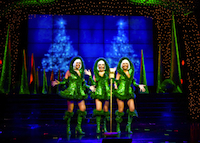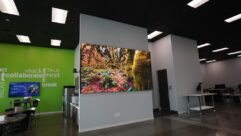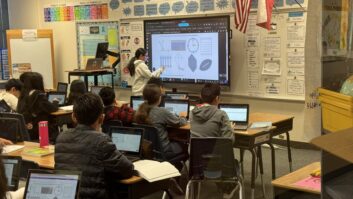

NEC video wall gives The Fabulous Palm Spring Follies a little extra kick
May 9, 2011 12:00 PM
NEC’s 5×5 video wall (using the 46” X461UN) addressed Plaza Theatre officials’
concerns about adding more visuals to the show without requiring more space,
as well as complementing the performers on stage rather than serving as a
distraction to them.
The city of Palm Springs, California, has a rich history as a winter hideaway for some of show business’ most legendary entertainers. Frank Sinatra, Bob Hope, Bing Crosby, Liberace, and many other stars of the Golden Era were fixtures on the Palm Springs scene. These luminaries often stopped at the Chi Chi, a Las Vegas-style watering hole, for a drink with friends and to try out new material before taking the big stage in one of Nevada’s top casinos.
Opened in 1936 for the world premiere of the motion picture Camille, the Plaza Theatre was an integral part of the action in Palm Springs. Besides functioning as a movie house, it was also a location-of-choice for radio broadcasts in the 1940s. Jack Benny performed his radio show at the Plaza regularly, and Bob Hope and Amos ‘N Andy were among the many programs that emanated from its stage.
By 1991, however, this once-shining jewel in the desert was shuttered and dark. That’s when Riff Markowitz, the recently retired producer of HBO’s The Hitchhiker and a man with an extensive showbiz resume, along with partner Mary Jardin, were approached by the Mayor pro tem of Palm Springs with a proposal: what could they do with this 809-seat former movie house, which the City had recently purchased and renovated to its former glory? Inspiration struck and the producing team decided upon a vaudeville-style musical revue reminiscent of the popular Las Vegas showrooms of the past.
Rather than bringing in young talent to play classic showgirls and entertainers from that era, they would use a cast that had performed on those stages then or had worked with those legendary actors. Everyone onstage would be 55 or older, and Markowitz himself would return to his performing roots to host the show—exploring, in his words, “the road not taken.” Thus was born the Fabulous Palm Springs Follies. To date, the show has played to more than 3 million people of all ages, and Markowitz is proud to point out he’s never missed a performance.
The Challenge
Since its first performance, the Follies had always set the mood for its performances with curtains and static billboards that could be rolled on and off stage on tracks. While it worked, and was authentic to the period being portrayed, it was also very limiting, particularly given the cramped quarters in which the show operates.
“Over the years, we’ve done some fairly miraculous things in terms of scenery and backdrops,” said Markowitz. “The Plaza Theatre was primarily a movie house. It was never intended for this type of production. The stage itself is small, and one wing is 15’x15′ while the other is 8’x4′, so there’s not a lot of room to keep boards on the side. There are no flies either, which means we can’t drop in scenery from above. We were always making tough choices when it came to setting the proper mood.” In early 2010, Markowitz started noticing video walls in some of the hotels in which he stayed. He thought the right video wall might provide the opportunity to do more with backdrops and scene setting, and brought the idea to Bob Feudi, technical director for the Follies.

According to Riff Markowitz, the show’s host, “The NEC LCD displays fit very comfortably into the show. Instead of looking like something you would see on an outdoor billboard or in a ballpark, they were bright and colorful enough to see without becoming intrusive.”
“The ability to add more backdrops and visuals to the show without requiring any more space was very appealing,” Feudi said. “But we also had some concerns, not the least of which was whether our audience would accept a video wall. It is a technology that didn’t exist during the time the show is portraying, so we had to make sure our approach to it fit. We also wanted to be sure it would be an enhancement to our live performers rather than a distraction from them. They’re our stars.”
One of the big concerns Feudi had was the resolution of the screens. He had seen video walls where the picture looked great from a distance, but up close the pixelation would make it difficult to recognize what the scene was. He wanted the backdrop to look great from every seat in the house. He also wanted it to look like one large, traditional-style backdrop rather than a group of individual screens.
Getting the color calibration to match was another concern. As a big, Las Vegas-style revue, the Follies would need a large video wall. Feudi and his team determined that a 5×5 size using large screens would create the impression Markowitz wanted while still holding them to a realistic budget. That meant calibrating 25 screens and keeping them matched for performances that often ran nine times per week, with matinee and evening shows. The same space considerations that led them to consider a video wall also created additional concerns.
“We needed the video wall to take up minimal space on the stage,” Feudi said. “Our idea was to attach it to a concrete wall at the back of the stage that has been there since the Theatre opened. But we also wanted the ability to ‘hot swap’ the screens, so if one was having a problem during a performance, we could replace it between shows, or even during intermission.”
Feudi and Markowitz auditioned LED and LCD screens from several manufacturers. Only one, however, really fit the part.
The Solution
The screens they selected for their video wall were NEC X461UN displays, 46″ LCDs with 1360×768 WGA native resolutions in a true 16:9 aspect ratio. Its groundbreaking ultra-narrow bezel (7.3mm screen-to-screen) and TileMatrix technology that can join up to 100 screens were ideal for the “bigger than life” impression the Follies wanted to create while acting as the background element the video wall was supposed to be.
NEC video wall gives The Fabulous Palm Spring Follies a little extra kick
May 9, 2011 12:00 PM

The addition of the digital video wall has changed the way the show’s directors are approaching its production. “We’re now spending a great deal more time doing video research, capturing and editing, and then incorporating it into the music,” said Markowitz.
“It had to be bright enough to withstand the high-power stage and spotlights we use, yet we didn’t want it to be so bright it was jarring,” said Markowitz. “The NEC LCD displays fit very comfortably into the show. Instead of looking like something you would see on an outdoor billboard or in a ballpark, they were bright and colorful enough to see without becoming intrusive. When the show is on you don’t notice the bezels, either, which help us create more of the old-time stage look.”
Having found the right screens, Feudi now needed to find the right partner to install them. On a recommendation from NEC, he selected Fluid Sound, a San Diego-based specialist in the design and integration of commercial audiovisual systems. The project was planned for the next time the Follies went on hiatus from performances.
“We had roughly three weeks to get the video wall installed, configured and running before the next show opened,” said Phil Borkowski, a partner with Fluid Sound. “It was an immovable date. You know the old showbiz motto—the show must go on. So we worked around their rehearsal schedules to get it ready in time for the curtain to go up.”
Most of the project went as planned, thanks to the combined efforts of Feudi, NEC and Fluid Sound, but there were still a few surprises—starting with the concrete wall to which they were planning to affix 3000lbs of display screens.
“When we were first looking at it, we drilled some holes in the wall and found it to be solid concrete,” Feudi said. “As we got into the installation, though, we discovered that wasn’t entirely true. Apparently, building codes in Palm Springs weren’t as stringent back in the 1930s. But the Fluid Sound guys checked it out and assured us it would still work. They knew what they were doing, which made us feel a lot better.”
The video wall was completed on-time and on-budget, which were the two key metrics for the project. Once the calibration of the 25 screens was completed, it created the perfect effect.
“I always want our audience to be focused on the performers and the material,” said Markowitz. “Their eyes should always be on the talent, not the movie going on behind them. I don’t want the audience to go out humming the scenery. The NEC video wall allows us to set the stage and keep our show the warm, intimate, human experience it’s meant to be instead of a rock and roll extravaganza.”
The content shown on the video wall ranges from a mix of photorealistic backdrops, with and without movement, and more artistic or conceptual renderings, depending on the mood they’re trying to set. For example, a New Orleans jazz number might have the performers singing and dancing in front of a photo of Bourbon Street, while a Christmas tune will show snow falling in the forest. For a vaudeville-style number, however, the video wall might show the type of painted backdrop used for stage shows back in the day.
“We weren’t sure how much we would use it at first,” said Feudi. “But as we got into it, we started incorporating it more and more. The video wall gives us an infinite variety of looks we can use, much more than we ever could achieve before. It’s become a tremendous enhancement to the feel we’re always working to convey.”
Markowitz has also been pleased with the payback the Follies has received on the investment.
“We’re now spending a great deal more time doing video research, capturing and editing, and then incorporating it into the music,” he said. “We’re using it more creatively and constructively throughout the entire performance, not just here and there.”
Feudi and Markowitz had high marks for Fluid Sound and NEC as well. They liked the professionalism and expertise both companies exhibited, as well as their willingness to go out of their way to make the technology work for the Follies—something Markowitz says you don’t often see from a large corporation.
“NEC talks about solutions on its website, but a lot of companies say things like that,” he stated. “We needed a solution, and that’s what they actually delivered.”
As for the future, Markowitz has never been one to dream small, as those who have seen his show can attest.
“We always strive to draw our audiences into the show, and make them feel like they’re a part of it,” he said. “Eventually we plan to expand the video wall to fill the entire stage background, side-to-side, and top to bottom. Now that will be a Vegas-style experience!”
Quick Facts
- Facility: The Fabulous Palm Springs Follies in the Plaza Theatre
- Location: Palm Springs, California
- Challenge: Create a video wall to serve as a background/enhancement to the live performers on a very small stage
- Solution: 46″ NEC X461UN in a 5×5 configuration
- Date: Fall 2010










